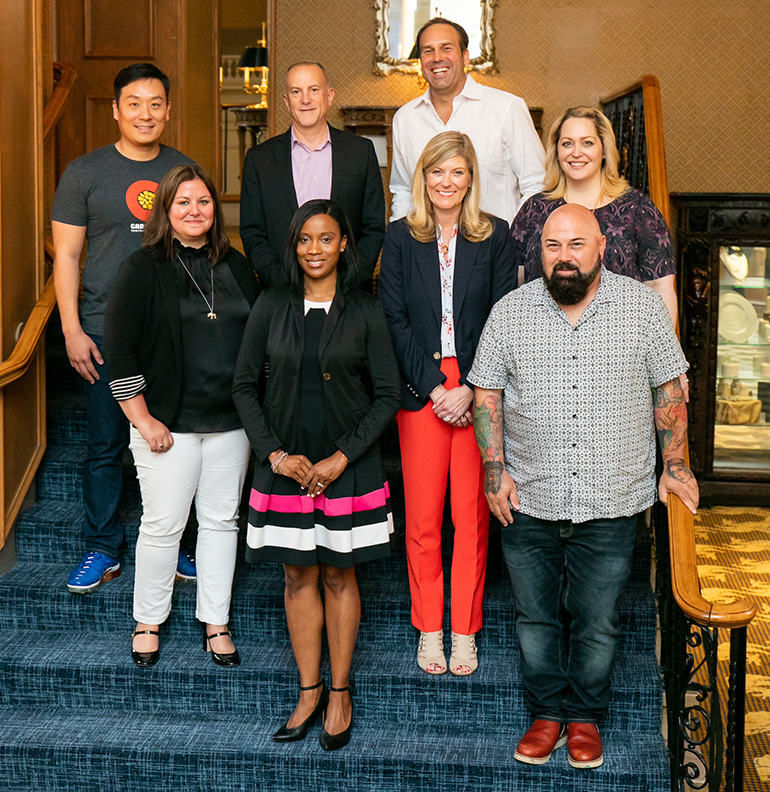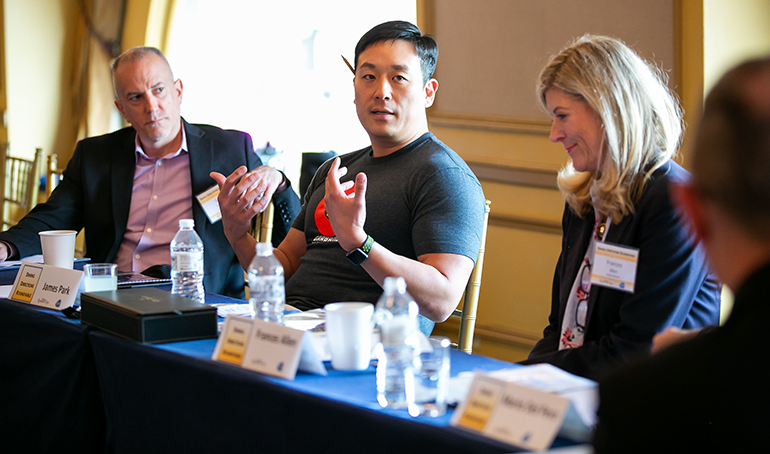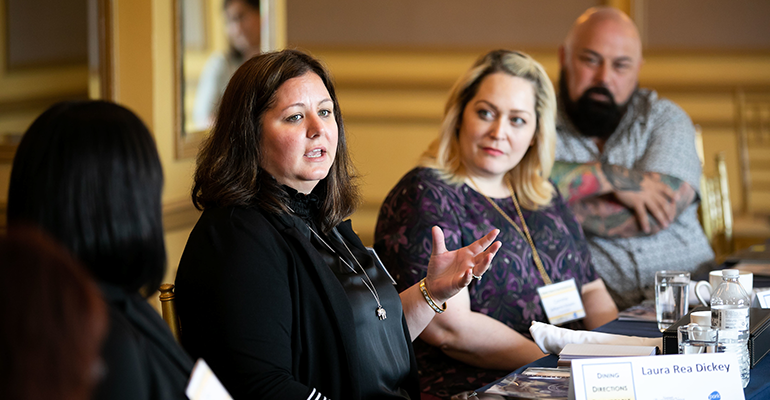Convenience, digital accessibility and Instagram-worthy aesthetics are all tools to drive traffic in today’s environment, according to seven restaurant executives who gathered this spring to talk about how they’re adapting to consumers’ evolving needs.
The conversation took place at the Dining Directions Roundtable, which was sponsored by the National Pork Board and held during the National Restaurant Association Show in May in Chicago.
The wide-ranging conversation focused on how the customers and their demands have changed in the past five years and the levers companies can use to drive sales.
Some the discussion centered around new research from the Pork Board, which recently surveyed more than 10,000 consumers. That study is available online at www.pork.org/marketing/insight.

Participants in the Dining Directions Roundtable, sponsored in May by the National Pork Board at the Drake Hotel in Chicago, included: (top, from left) James Park, Scott Uehlein and Mario Del Pero and (bottom, from left) Laura Rea Dickey, Tara Dugan, Frances Allen, Cammie Spillyards-Schaefer and Brian Ingram.
Dining Directions participants were:
- Frances Allen, CEO of Boston Market
- Mario Del Pero, co-founder, Mendocino Farms
- Laura Rea Dickey, CEO, Dickey's Barbecue Restaurants
- Tara Dugan, director of consumer and marketplace insights for the National Pork Board
- Brian Ingram, chief development officer of Williston Holding Co.
- James Park, CEO of Garbanzo Mediterranean Fresh
- Cammie Spillyards-Schaefer, vice president for culinary and menu strategy for Cracker Barrel Old Country Store
- Scott Uehlein, vice president of product development and innovation for Sonic Drive-In
- Ron Ruggless, moderator and Nation’s Restaurant News senior editor
Here are highlights of the discussion:
Ron Ruggless, NRN: What have been the biggest changes in your consumer in the past five years?
Laura Rea Dickey, Dickey’s: One of the largest changes that we've seen, especially in the past couple of years, is definitely convenience driven. Our third-party, our delivery business, is a huge component to the business that didn't exist five years ago. And I think another change is … on-premise transaction counts climbing again, through different intentional initiatives. We're seeing folks who want the experience. We've opened our kitchens so they can see the [barbecue] pits. They can see the food being prepared, and that's become an expectation.
Cammie Spillyards-Schaefer, Cracker Barrel: One is the desire to tailor their in-restaurant experience. The same consumer will use you for different occasions and different needs and they expect that you can read that experience for them and adjust to what they need. Whether that's quick — I'm just here to fill up at the Cracker Barrel as I'm traveling down the road — or whether I'm there to connect with my family, and I want a more experiential kind of visit. The other thing that is big for Cracker Barrel is the need for convenience at holidays, which I think has changed rather dramatically over the years. People aren't cooking on those occasions that they really used to hold sacred and cook for. We’re seeing a real demand for, “Help me make this easier, but I still want to feel good about what I'm serving my family.”
Brian Ingram, Williston Holdings: The consumers are so much more educated now. Everybody watches Food Network. Everybody watches a cooking show. Your kids are on “Top Chef Kids.” You just can't get away with what I would call the simple things anymore. You have to bring your A Game in restaurant space.
Scott Uehlein, Sonic Drive-Ins: Digital has been a huge unlock for us. It's about knowing our customer a lot more than we did five years ago — and that's probably even in the last 12 months — and understanding why they're coming to us, when they're coming to us on different occasions. Speed and convenience is definitely one. The mobile app is a huge unlock. Order ahead from the customization standpoint for the operation is an unlock because somebody can customize that without having to speak to a human being. It prints in the kitchen. The ticket is ready to go. The customer drives us.
Frances Allen, Boston Market: Convenience is the big thing. We were the original home meal replacement, and that's really where we started and became incredibly successful as a result. … We've seen a huge uptake in delivery sales and have gone with every third party that is worth our time because that's really what our consumer is looking for. They don't want us to dictate to them whether they go on DoorDash or Uber Eats. They want to go on the platform they want to go on. We've definitely seen a big change and increase in our delivery sales. Innovation is absolutely key, and, for us, they're interested in innovation around proteins. So a big win for us last year was prime rib, and 30% of those sales were new customers to us. … The delivery customer is definitely less price sensitive. … You've got a third of the population that earn over $70,000 a year. That's where the delivery customers are coming from.
Mario Del Pero, Mendocino Farms: I'm only 20 to 21 years in the business, but this is by far the most interesting time in the restaurant space, I mean, with the advent of technology, with consumers just, you know, being more informed and caring and actually willing to pay for it. … What we are finding is our dining rooms are massively changing, which is tough when you're a growing brand. … Our expo station has almost doubled just to be able to handle all third-party delivery and online orders. That's revolutionary. The fact that now, actually, almost 60% of our product is eaten off-premise — 20% of that in catering, almost 10% in third-party delivery. Our core guest — that Lululemon mom — we do everything for her and what her needs are. … We've started to look at grab-and-go. Can we make it even more convenient?

Ruggless, NRN: What levers can you pull to drive sales at your restaurant?
Del Pero, Mendocino Farms: I don't think it's price. I truly believe it's value. Everyone wants a deal, and they want it at a great price. The more that we can share with them the quality of our ingredients, the more it doesn't look expensive. It actually is an incredible deal. … One of the great levers we have is to make sure that we're very thoughtful around pricing. Our phrase is, we want to have Whole Foods market quality at Panera prices. The other thing is definitely innovation. … We just recently had a pig rancher call us. A restaurant group cancelled its order and he raised 30 giant pigs, and we immediately created … a Pachamama Bocadillo. … We ground the whole thing and made chorizo with it, did a serrano ham with a Spanish oil drizzle across it, goat cheese, Arugula and created this very indulgent sandwich that sold great.
Allen, Boston Market: Last year was about prime rib. It was about expanding delivery options and then really getting growth in the holiday business, which we achieved last quarter — fourth quarter of last year. This year it's all about data and building and getting to a place where we can actually interact with our guests digitally as opposed to on TV. That's a big change for us. But we were literally getting to a place where we could no longer afford TV campaigns that would stand out and make the kind of investments that we needed to make in digital. So this year a lot of focus on what I will say, relevant digital messaging.
James Park, Garbanzo: You've got to be an inch wide and a mile deep and do it better than everybody else. … Every customer should be asked to join the rewards program … you need to have many people in there, because that's your currency, the ability to communicate with these guys. Even if you think it's worthless, at some point they're going to go, “I'm going to give it a try again.” I don't care if you're giving them 10 free meals, they're giving you their personal information, their telephone number, their home address, they're vegan, vegetarian diet and then you market the hell out of it, right? And you tell your marketing guys, don't worry about all the noise. Focus on existing customers, get them to come back more. Focus on the existing customers that we don't have their information and get that information. Find out as much as you possibly can.
Uehlein, Sonic: Value, what you get over what you pay. And part of that for us is price. For us, there's definitely a price piece to value. Technology, including order ahead and including digital marketing, and the shift from the carpet bombing of advertising to much more targeted technology and marketing, and then constant innovation, so those are probably the three levers that we pull. And the constant innovation has always been there.
Ingram, Williston Holdings: It's going back to that loyalty and the folks that have been coming to us for 30 years, and they're second generations and their parents brought them. If you stray too far from what brought you to the dance, they get upset with you.
Spillyards-Schaefer, Cracker Barrel: It starts with what we're known and loved for, so our craveable signature menu items — whether that be biscuits, then we did a new twist on those with our biscuit beignets, or whether that be chicken and dumplings or hash brown casserole — things that people know and love us for a long time. For us it's not about discounting, but it's about that price assuredness for every visit. When we get that combination right is when we have really seen success. Fried chicken is a great thing. We just rolled out in April for the brand. Funny, because it's something people thought we had already, bone-in fried chicken. It just seemed like a natural fit for Cracker Barrel, because it's a natural fit for Cracker Barrel.
Del Pero, Mendocino Farms: I thought you had it.
Spillyards-Schaefer, Cracker Barrel: I know, so did everybody. We're very excited about the success of that product. There's a couple other levers, I'd say here, too. For us, it's all about guest experience as well and a hyper-focus on our guest experience. I think of Cracker Barrel as being eatertainment before eatertainment was cool. We have, you know, certainly kind of the games and the disconnect at your table with your family, but retail being a huge part of our experience as well.
And then certainly off-premise has been a new lever growing traffic and sales. … That's a different consumer very often. … Interestingly, they order the same items, which is very interesting. It's just not a guest who was coming to our physical location.

Mendocino Farms co-founder Mario Del Pero makes a point.
Dickey, Dickey’s: I've been an early adopter in third-party, and that's a huge, huge component. And we've always been caterers. So that's always been part of the story. … Our original location that has been open since 1941, and is still open and operating, never closed. We added a bar and patio. We actually took it and repurposed the historic to-go area into a full-service bar and added part of a gravel patio area with a lot of the games to make that just again that additional experience, but we're also complementing that kind of threefold. We're doing a huge repush in loyalty. We've always had a loyalty program, but we do most of our technology development in-house, and so that was a huge focus. … And then we have what we call a seasonal LTO or innovation driving that is not price-point sensitive. We just finished our au jus pit dip sandwich, which was a new culinary driver. Later in the year will actually be the pulled pork burnt-ends.
Ruggless, NRN: In the National Pork Board research, Tara, was there anything that popped out to you as what might impact consumers effectively?
Dugan, National Pork Board: You know, there are definitely several levers that impact consumer buying behaviors. Speaking to the flavorfulness of the menu items is incredibly important. Then also from a social media influence perspective, that's also another lever that we've seen be really valuable. That comes in a couple different forms. One is Zagat actually did a study not too long ago that identified that over 70% of consumers who browse photos online for food actually will go to that restaurant based on what they've seen. We know that that can come from a couple different sources. It could be my friend on Facebook or it could be going on to Yelp or going on to the restaurant website itself and seeing it there. The other thing is making sure that you have relationships with influencers. … At McDonald's, I worked on innovation and consumer insights. Innovation is interesting, especially in the world of delivery today, because how do you have a platform where folks can just hit a button and place an order that they already have in queue, but then also have those LTOs visible and have awareness of those new items that also do a job in driving traffic and enticing folks to try new items.
Dickey, Dickey’s: It's really interesting what you say that about browsing food online. Our new inside baseball rule is: “The phone eats first” is what we call it, because people come in and if they're going to Insta[gram] their food or their plate, then we've done something right.
Del Pero, Mendocino Farms: “The phone eats first.” That's great.
Dickey, Dickey’s: And it's a training tool, because then we can take that back and challenge the pit master to go, “Have you highlighted the smoke ring? Are the burn-ends really plated well?” But it really does drive its own customer transaction piece.
Allen, Boston Market: There's a trend in design right now to make sure that the right lighting is over the table so that people can actually create that.
Del Pero, Mendocino Farms: We make sure there's Instagrammable walls that we have for people to hold up their sandwiches. I mean, we're hoping, but literally it's in our design, that where's our Instagrammable wall.
Uehlein, Sonic: For us it's really about the product. When you're in your car, you're either driving through or you're driving up. We don't have that many dining rooms. The food itself, you want people to be able to snap it and post it. The PR buzz. That's another big thing when we look at innovation. You're thinking, will this be “PR buzz worthy” as well.

Scott Uehlein, Sonic Drive-In VP; James Park, Garbanzo Mediterranean Fresh CEO; and Frances Allen, Boston Market CEO.
Ruggless, NRN: In a hashtag, short word or phrase, what are you most excited about in the industry today?
Dugan, National Pork Board: I think that we are certainly in a foodie culture, and even if we think about younger demographics, folks have really, really open palates and open minds to trying new and unique things. Foodie. Hashtag foodie.
Dickey, Dickey’s: Specialization. Instead of being a jack-of-all-trades, [customers] really want a master of what you do well. Whether that's the right spice, the right sauce, it comes from the foodie culture that's the specialization that's just driving better and more unique and more interesting and different areas of business definitely.
Spillyards-Schaefer, Cracker Barrel: Evolution. I've read articles over the years all the time saying is this segment of the industry dead, are we ever going to see it? It's like, yeah, of course, it's not dead. The things have all moved and changed. Some areas are a little slow and some areas are doing a good job, but certainly evolution.
Ingram, Williston Holdings: I think innovation for me is what's going to be coming. I mean, the food world has changed so much in the last five years, when the Brinkers and the Applebee’s and the Dardens were the kings. And now it's just so crazy to see all of this growth and all the new players.
Uehlein, Sonic: Yeah, he stole mine. Innovation. … There is innovation. There is automation. There are all these things that are happening on all kinds of different levels … it feels like the industry is sort of on the cusp of this massive change. It’s happening front of the house; it's happening back of the house. It's happening in food, ingredients. It's across the whole building. And outside of the building, because there's innovation happening in farming, and there's a movement toward less antibiotics and purer ingredients.
Allen, Boston Market: Hashtag personalization. … I'm looking forward to being able to narrow the [messages] down to individuals with either innovation news or value offers or different ways to get a quality message across.
Del Pero, Mendocino Farms: I was going hashtag convenience, we've already covered it. I was going hashtag sustainable. I think I am going to land at the hashtag loyalty. I think that with all of the data now being able to have this deep, deep relationship with our guests and to continue to deepen that connection, I think our industry over the course of the next five years is going to revolutionarily change with the level of relationship that we're going to have with our guests in understanding how they use us, why they use us and how they would like to use us.
Contact Ron Ruggless at [email protected]
Follow him on Twitter: @RonRuggless

